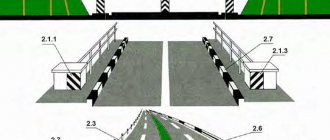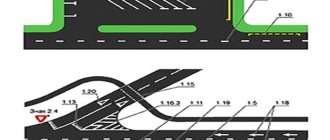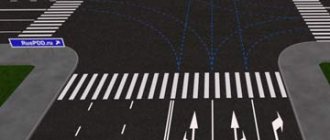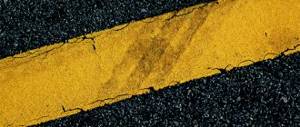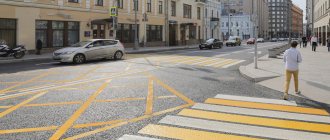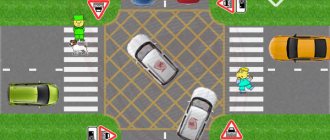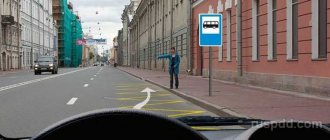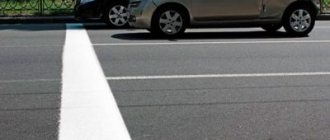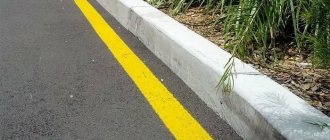Violations related to crossing road markings in the form of a solid line are a very common administrative violation.
Whether it is done intentionally or out of ignorance does not matter, the responsibility is the same, since it is strictly prohibited.
With this violation, there are many controversial situations; let’s further consider what they are and what fines are provided for this.
Before reading the article further, look at what road markings 1.1 look like.
Horizontal layout 1.1:
What is the fine for crossing marking 1.1 in one direction?
The set of provisions that regulates fines and other types of punishment for administrative offenses is regulated by the Code of Administrative Offenses of the Russian Federation.
According to part one of Article 12.16 of the Administrative Code, driving through a solid line in the same direction without complying with the requirements of road markings 1.1 entails a warning or a fine of 500 rubles .
For example . On a 4-lane road, the driver of a passenger car (A) decided to overtake a cargo vehicle (B) in front of the bridge. To the left of it is a horizontal marking 1.1, indicating the prohibition of crossing. Driver A crossed the solid marking line while passing! direction, but he committed this action in violation of traffic rules. Therefore, he will face punishment in accordance with Part 1 of Art. 12.16 Code of Administrative Offenses of the Russian Federation.
When turning through a solid lane 1.1 in order to change lanes in another direction from 1000 to 1500 rubles, Art. 12.16, part 2.
What is written in the traffic rules?
In order to avoid warnings and fines for crossing a solid line in the same direction, you must strictly adhere to the Traffic Rules.
The main points of the traffic rules regarding the intersection of solid lanes:
- Clause 9.1(1). On any two-way roads, driving in the lane intended for the oncoming direction is prohibited if it is separated by tram tracks, a dividing strip, markings No. 1.1, 1.3 and 1.11.
- Clause 9.2. When driving two-way traffic on roads that have four or more lanes, when passing or overtaking, it is prohibited to enter the lane along which oncoming traffic is taking place.
When can you cross a continuous road without a fine?
There are only a few exceptions to the rules for which there are no penalties.
You can cross an unbroken line in the following cases:
- when going around an obstacle on the road for oncoming traffic;
- if necessary, overtake a slow-moving vehicle, which is marked with a special sign;
- due to extreme necessity to avoid an accident or collision with a pedestrian.
You can avoid obstacles according to the rules without any problems if you have a road sign 4.2.2. In this it takes precedence over markup. It is important to remember that there is no advantage over oncoming traffic, so when performing this action you need to be extremely attentive and careful.
When overtaking slow vehicles crossing a solid line, you must first of all focus on the sign installed on them. It designates a low-speed vehicle and looks like a red triangle, along the perimeter of which there is an orange or yellow stripe.
If there is such an identification symbol, you can safely ignore even the requirement of sign 3.20 “Overtaking is prohibited.” In its coverage area you can overtake horse-drawn carts, bicycles, and mopeds.
To prevent a collision with a pedestrian, which poses a serious danger to his life and health, the driver can violate any traffic rule (Article 2.7 of the Administrative Code). The main thing is to preserve the evidence obtained using the car recorder.
Purpose of demarcation strips
Reference: demarcation stripes refer to horizontal road markings. Their main purpose can be judged directly by their name - this type of marking is designed to divide the road surface into lanes and zones.
Boundary strips include:
- Single continuous strip , its purpose is to separate traffic flows in opposite directions and mark the boundaries of traffic lanes in dangerous places on the roads. Indicates the boundaries of the roadway where entry is prohibited, and also demarcates parking spaces. In the traffic rules of the Russian Federation it is listed under number 1.1. It can be permanently white, temporary – orange. The latter is used during construction or repair work.
- A solid line in the same direction is a demarcation strip, which is usually applied to systematize the flow of vehicles in one direction. Such a line can be seen in tunnels, on bridges, when approaching an intersection.
- A double solid lane is used when there are more than 4 or more lanes on the road. In the traffic rules of the Russian Federation it is listed under number 1.3. Read about the driver's responsibility when crossing a double line in this article.
- A single solid stripe with a dotted line on the left side - to indicate places where changing lanes is allowed only on one side (No. 1.11).
- Thick solid strip - used to mark the edge of the roadway (No. 1.2). A solid line may also indicate the boundaries of the parking zone.
The photo shows markup 1.1:
Below is a photo of markup 1.3:
Below you can see a photo of the 1.11 markup:
Check out the photo of markup 1.2:
Markup 1.1
June 7, 2013 Administrator Home page » Road markings Views:
Horizontal road markings, along with road signs, seem to be a fairly convenient and effective means of regulating traffic. But this is so, the preamble...
Any driver - both beginner and experienced, and even a guru - should know that the most odious option for horizontal markings is the “single solid line” - marking 1.1. Let's try to figure it out.
First of all, we note that in matters of qualification of markup 1.1, two significant circumstances are important.
First: road markings 1.1 are used primarily “inside” the roadway, and not on its edge (bordering, for example, the shoulder).
And the second circumstance (probably the most important): marking 1.1 - “single continuous” IS STRICTLY PROHIBITED TO CROSS FROM ANY SIDE. And not only when overtaking, but also when going around obstacles.
Keeping these two circumstances in mind (and especially the second), let's try to consider the principles of using markup 1.1.
“Single solid” is used in the following four cases. Note that no other type of horizontal marking is used so widely. So…
1. “Single solid” to indicate traffic lanes on roads with two and three lanes (in both directions)
First of all and most often, marking 1.1 is used to separate traffic flows in opposite directions on two- and three-lane roads.
“Single continuous markings,” judging by the picture, categorically prohibit leaving the occupied lane into the oncoming lane. In other words, the driver is obliged to move strictly in his lane.
Marking 1.1 on a three-lane road will also prohibit driving into the oncoming lane and indicate the need to follow only “your” lanes (or “your” lane).
Let's think about which sections of the road with two and three lanes is it advisable to apply “single solid”? Did you guess it? That's right, in dangerous areas that involve:
1) With sharp turns and/or limited visibility to prevent entering the oncoming lane;
2) Approaching intersections, railway crossings, pedestrian crossings or intersections of roadways with bicycle paths;
3) With a lane for fixed-route vehicles (and passenger taxis), when access to it is strictly prohibited.
Thus (let’s summarize the preliminary results!), marking 1.1 - “single solid” - is used on two- and three-lane roads in order to prevent a vehicle from entering the lane intended for oncoming traffic.
2. “Single solid” to indicate traffic lanes on roads with two and three lanes (in one direction)
The second - also quite frequent - case of using marking 1.1 is its application on a multi-lane (four-lane or more) road to designate traffic lanes within one direction. This is done in order to eliminate the possibility of vehicles changing lanes from one lane to another.
And again let us ask ourselves: in what cases does such a need arise? Yes, on the same dangerous sections of the road associated with:
1) Approaching an intersection, pedestrian crossing, railway crossing;
2) A lane for fixed-route vehicles (and passenger taxis), when entry into it is expressly prohibited.
Consequently (let’s sum up one more preliminary result!), “single solid” (or marking 1.1) is used on four or more lane roads - “INSIDE” one direction of travel - to limit the possibility of vehicles changing lanes from one lane to another when this maneuver unsafe.
3. “Single solid” to indicate parking spaces
Marking 1.1 can also be used in special areas intended for parking vehicles, as well as in sidewalk parking lots.
In this case, the “single continuous marking line” forms the very “box” within which you should place your “iron horse”. The driver must strictly follow the parking rules prescribed by marking 1.1 and not throw his car across parking spaces.
Otherwise, he grossly violates the rules and may be subject to administrative penalties. And, believe me, this is the best case scenario! At worst, a stone hits the windshield or a punctured tire (“surprise” from the car owner who did not get a parking space due to someone’s rabid and outright “not giving a damn”).
So (another conclusion!), marking 1.1 can also be used in parking areas to designate a parking space intended for parking one vehicle.
4. “Single continuous” for areas where entry is prohibited
“Single continuous” can also be used in very specific cases: to mark the boundaries of a traffic island, a guide island, and other cases where there is a need to prohibit entry to such areas.
Take, for example, horizontal markings indicating the point of merging or separating traffic flows (we will talk about this more specifically in subsequent comments).
Have you noticed that the boundaries of this marking are marked “single solid”. This means that driving onto this section of the road is strictly prohibited.
Consequently, in this case too - when it is necessary to prohibit entry to any area - marking 1.1 is a powerful and effective traffic regulator.
Now let's summarize.
Marking 1.1, or “single solid”, is used:
firstly , to highlight traffic lanes from which exit is prohibited; secondly , to designate parking spaces on parking lots or near sidewalks; thirdly , to indicate areas to which entry is strictly prohibited.
And, most importantly, it is strictly forbidden to cross “single continuous” markings from any side. Violation of this principle leads to quite serious administrative penalties, including deprivation of a driver's license.
If this information was useful to you, please write about it in the comments. If you have any questions, write, I will definitely try to help you.
Traffic regulations online from the autoass team!
The content of the article:
- marking 1 1
- road markings 1 1
- solid line marking
- traffic rules 1 1
Tags: marking 1.1, continuous marking
Errors when crossing a solid line
- Changing lanes in a different direction. A situation that occurs quite often on our roads. The driver, without waiting for an intersection or a turn, an intermittent line, hurries to change the direction of movement and crosses a solid line. Let us remind you that for such an act he will face a fine ranging from 1000 to 1500 rubles. according to Art. Code of Administrative Offenses 12.16, part 2.
- Attempt to overtake. The driver, neglecting traffic rules, overtakes, enters the oncoming lane and crosses the solid lane 1.1. For such a violation in accordance with Part 4 of Art. 12.15 Code of Administrative Offenses will be 5,000 rubles or deprivation of rights for crossing a continuous road for 4-6 months.
- An attempt to avoid an existing obstacle. Often, drivers encountering obstacles on the roads in the form of broken down cars, repair work, cross a continuous lane into the oncoming lane. This administrative violation is subject to punishment, which is regulated by Part 3 of Art. 12.15 Code of Administrative Offenses - a fine of 1000-1500 rubles.
Important: it doesn’t matter what is being crossed - a double and a single solid line are equivalent markings, the intersection of which is strictly prohibited.
Fines
Now let’s look at a pressing issue for all drivers – what fines they face for violating the requirements of yellow markings.
Fines currently in effect:
- The driver will pay 500 rubles if he does not give way to a bus (trolleybus) in the yellow zigzag zone.
- 1500 in the regions, and in Moscow and the northern capital more than 3 thousand, a fine for crossing a continuous or single broken road. And the car enthusiast will say goodbye to his car for a while - he will be evacuated to a parking lot.
- 1,500 rubles is the fine for not allowing a pedestrian to cross at a yellow crossing.
- Moving backwards or turning around on it is punishable by a fine of 500 rubles.
- Overtaking on a yellow crossing will be expensive - 5,000, in some cases a license deprivation of 4-6 months is applied. If such an administrative offense is committed repeatedly - for a year.
- If the driver parked near a crossing or stop - 1000, in the capitals - 3000 rubles.
If you are not sure about the correct interpretation of yellow signs on the road, then it is better to park in another place where there are none, so as not to pay fines or not walk at all.
If the markings are not visible
Lines and signs of any color on highways are periodically maintained in accordance with standards. But they are often covered with dirt, sediment, or even erased. Then the motorist has to navigate by the signs. And what if they don’t exist? Then he is recommended to determine his own and oncoming lanes by eye, taking into account the width of the road and the dimensions of the cars. Traffic participants are not required to guess all other lines and patterns hidden under the snow or erased.
Summarizing the above, it is clear that yellow lines on the roadway are associated with stopping or parking. When choosing a place for these maneuvers, it is recommended to pay attention to them in advance. They perform the function of regulating traffic, just like signs. People’s health and lives depend on knowledge and fulfillment of their requirements - the driver needs to remember this.
Controversial issues and ways to avoid punishment
The most common controversial situations, as well as ways to avoid punishment in them, are:
As we see, in many controversial issues it is possible, if not to completely avoid punishment, then to minimize the cost of fines. And if you pay within 20 days after receiving the decision, the driver will be able to count on discounts when paying the fine.
